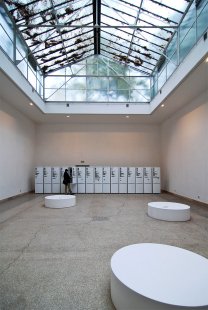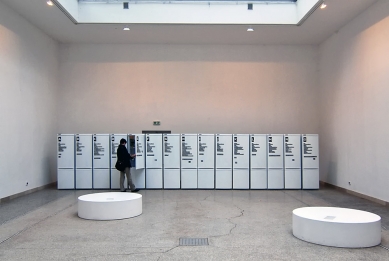
Sideways
The exhibition of the Czech and Slovak Republics at the 11th International Architecture Biennale in Venice

Authors of the project and implementation: the association zerozero untd. from Prešov (www.zerozero.sk): Marcel Benčík, Irakli Eristavi, Martin Jančok, Silvia Miklušová, Pavol Šilla
Exhibition curators: Alexandra Kusá and Monika Mitášová, SNG in Bratislava. Cooperation: Katarína Hrdá. The project is created in cooperation with the Slovak National Gallery in Bratislava and the National Gallery in Prague.
“The Sideways installation poses questions and seeks answers in the realm of non/architecture. Fulfilling human needs is the concern of every person, regardless of their social and economic status. Can we gain access to more realistic and authentic information about our individual habits, desires, and expectations by analyzing our needs? Where can architects learn more and how can they better respond to our rapidly changing world?”
“The station does not offer a choice between lentils and caviar. We find ourselves faced with the alternative of two lower-level dining products. One was shaped by the machinery of advancing globalization, the other prepared by the hands of local vendors. In this dining alternative, I ask whether it is not a metaphor for all products intended for mass consumption. Anywhere where it is about meeting mass needs, we should expect to stand before a similar choice as offered to a hungry traveler at the station. The means of mass communication, television and radio stations continuously repeat that they have a wide range of programs for us, where everyone can find something. In reality, they present us with two options that we know well from the station environment: will you prefer a Big Mac or a sausage?”
“Making it Safe to Be Hungry.” / “You can afford to be hungry.”
Exhibition curators: Alexandra Kusá and Monika Mitášová, SNG in Bratislava. Cooperation: Katarína Hrdá. The project is created in cooperation with the Slovak National Gallery in Bratislava and the National Gallery in Prague.
“The Sideways installation poses questions and seeks answers in the realm of non/architecture. Fulfilling human needs is the concern of every person, regardless of their social and economic status. Can we gain access to more realistic and authentic information about our individual habits, desires, and expectations by analyzing our needs? Where can architects learn more and how can they better respond to our rapidly changing world?”
zerozero untd.
“The station does not offer a choice between lentils and caviar. We find ourselves faced with the alternative of two lower-level dining products. One was shaped by the machinery of advancing globalization, the other prepared by the hands of local vendors. In this dining alternative, I ask whether it is not a metaphor for all products intended for mass consumption. Anywhere where it is about meeting mass needs, we should expect to stand before a similar choice as offered to a hungry traveler at the station. The means of mass communication, television and radio stations continuously repeat that they have a wide range of programs for us, where everyone can find something. In reality, they present us with two options that we know well from the station environment: will you prefer a Big Mac or a sausage?”
Miroslav Marcelli
“Making it Safe to Be Hungry.” / “You can afford to be hungry.”
Advertising slogan selling refrigerators by GE Co.
The Sideways project invites visitors of the Czech and Slovak pavilion to taste and test food as well as architecture. The pavilion is filled with the same refrigerators hiding secrets. Are the refrigerators archetypes of safe sorting, storing, and cooling of products? Are they accessible, simple means for tasting them right in our homes and public spaces? Or do they also function as peculiar spatial "taste cells/slits," "de-generators of sorting," or means bringing "losses from storage"? The refrigerators installed in the pavilion also carry records of socio-urban research mapping the interactions between refrigerators and their users living in various apartments and houses on the territory of Slovakia. The research protocols "filled in" by the residents - users of the refrigerators pose various questions. Are refrigerators merely refrigerators of uniformity and globalization, or of uniqueness and localization? Are they not also "coolers" and "melting pots" of our perception, experience, and pleasures of this world? What if they also function as risky "de-generators" of hybrid, non/architectural actions, events, and situations? Visitors of the pavilion can open any refrigerator located in the pavilion and taste/test the contents of its insides along with the center and side spaces of the pavilion, which debates the seemingly evident understanding of what today is (and what can be) architecture behind buildings. Please: taste and test! mm + zerozero untd.press release SNG, 4.9.2008
The English translation is powered by AI tool. Switch to Czech to view the original text source.
0 comments
add comment













